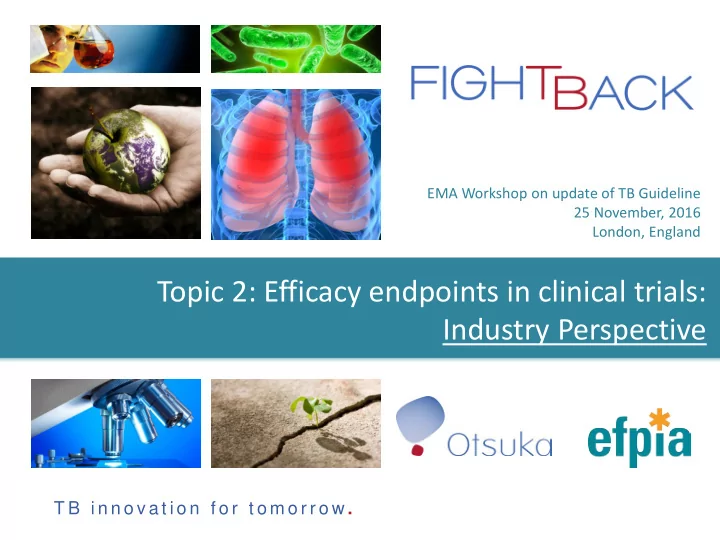

EMA Workshop on update of TB Guideline 25 November, 2016 London, England Topic 2: Efficacy endpoints in clinical trials: Industry Perspective T B i n n o v a t i o n f o r t o m o r r o w .
Efficacy Endpoints and Efficacy Assessment − Microbiologic • Early Endpoints Early Bactericidal Activity Sputum Culture Conversion (Initial and Final) Time to Positivity • Late Endpoints Primary Treatment Failure Sustained Conversion Relapse − Non-microbiologic • Death • Resolution of Signs and Symptoms including imaging − Host Factors − Efficacy Assessment: Selection of the Comparator Proprietary and Confidential 2
Early Bactericidal Activity (EBA) − Model developed by BMRC; Jindani et al. Am Rev Respir Dis. 1980, 121:939-949 − Design Patient population = newly diagnosed, previously untreated, AFB smear • positive pulmonary TB patients • Treat with single drug or drug combination for 14 days compared to an active control (HRZE) • Overnight, pooled sputum collection and culture Quantitative culture on solid media Assessment of time to detection in automated liquid culture system − Highly predictive of bactericidal activity for current HRZE regimen, assumed to be predictive for new drugs and regimens BMRC = British Medical Research Council; H = isoniazid; R = rifampicin; Z = pyrazinamide;E = ethambutol Proprietary and Confidential 3
Sputum Negativity and Sputum Culture Conversion (SCC) − Proportion sputum negative reported in BMRC trials and used by Wallis et al. to predict relapse with various therapy − Requires at least 2 sequential negative sputum cultures (28 days apart) • Initial (phase 2B) and final (phase 3) sputum SCC • Correlates well long-term outcomes for populations Association of mortality and successful treatment with SCC at 2 months in MDR- TB patients* Achieve 2 Treatment Success at Mortality at 4 years Month SCC 24 Months Yes 930/1090 85.32% 42/1090 3.85% No 1068/1852 57.67% 309/1852 16.68% *Unpublished data from investigators of the Collaborative Group for the Meta-Analysis of Individual Patient Data in MDR-TB Wallis, Peppard and Hermann. 2015 PLoS ONE 10(4):e0125403. Proprietary and Confidential 4
Time to Positivity (TTP) − TTP most often measured in automated liquid media culture systems − TTP provides a measure of rate of bacterial clearance and regimen activity over time that might not be captured in the proportion SCC − TTP can be affected by drug carry-over in sputum − TTP can be affected by differences in bacterial populations Proprietary and Confidential 5
Late Microbiologic Endpoints − Primary Treatment Failure • Failure to achieve negative sputum culture by a given time point may indicate the failure of a regimen A 4-month regimen should result in >99% negative cultures by the end of 2-months treatment (Wallis, Peppard and Hermann. 2015 PLoS ONE 10(4): e0125403) − Sustained Conversion/Reactivation/Reinfection • Isolated positive cultures may not be an indication of reactivation of disease Five-year follow-up shows low risk of reactivation (Hong Kong Chest Service/BMRC Am Rev Respir Dis 1987; 136:1339 and Am Rev Respir Dis 1988; 137:1147) Genotypic analysis may help differentiate reactivation from reinfection or contamination • Repeat positive cultures with the same genotype as the baseline isolate are likely indicative of reactivation of disease Proprietary and Confidential 6
Non-microbiologic Endpoints − Mortality Excluding deaths clearly not linked to study drug included in the draft guideline • • Analyzing all deaths at least as a sensitivity analysis, including mortality assessment of patients withdrawn from the study − Resolution of Signs and Symptoms • RCT of streptomycin assessed radiographs, general condition, temperature, body weight, sedimentation rate and bacillary load • Measuring changes in cough frequency, BMI, inflammatory markers and advanced assessment of chest radiographs − Imaging • Assessment in changes in serial chest radiographs (exploratory end point in Otsuka Phase III trial) • Proposed evaluation of PET/CT to measure changes in inflammation and structural damage of the lung − Host factors and Biomarkers Multiple cytokines proposed as markers of disease progression and cure • • Measurement of LAM in sputum as a biomarker of bacterial load Proprietary and Confidential 7
Efficacy Assessment: Selection of the Comparator − Gold standard comparator is always the concurrently enrolled, randomized control − Non-Concurrent (Historical) Controls • Suggested in some discussions around studies of AMR (anti-microbial resistance), particularly infections with high mortality • MDR/XDR treatment paradigms and outcomes dramatically changing MDR-TB 1996-2000 2001-2005 2006-2010 5 year cohort (N=86) (N=125) (N=123) % Success 53.5% 68.8% 83.7% % Mortality 10.5% 8.0% 4.1% Kwak et al. Int J Tuberc and Lung Dis. 2015, 19(5):525-530 “This improvement could be explained by the broader use of FQ’s and the introduction of linezolid” • Non-concurrent control must be as similar as possible to a cohort of patients treated with a regimen that would be approved as a control by an IRB today Proprietary and Confidential 8
Summary − Microbiologic endpoints are likely to remain the gold standard for quite awhile • SCC or proportion negative at early time points • Sustained conversion for 6 – 12 months as the only marker of bacterial sterilization − Non-microbiologic endpoints • None are validated as an endpoint for cure but may be useful as early markers of efficacy − Host factors and Biomarkers • None are validated as endpoints for cure • Likely to first be used as drug development tools Procedures for qualification of new Drug Development Methods are available Proprietary and Confidential 9
Thank you! Proprietary and Confidential 10
Recommend
More recommend